Once upon a time, people who needed to do engineering calculations, for
instance as part of an aircraft design, did them with a slide rule.
Faber Castell slide rule
 My father used this
slide rule
for engineering calculations,
probably as early as 1938.
It's made of wood, with a cardboard sleeve with the name Faber Castell
on it.
The rule is 12 inches long, or about 300mm.
The longer a slide rule is, the more accuracy you can obtain.
My father used this
slide rule
for engineering calculations,
probably as early as 1938.
It's made of wood, with a cardboard sleeve with the name Faber Castell
on it.
The rule is 12 inches long, or about 300mm.
The longer a slide rule is, the more accuracy you can obtain.
British Thornton slide rule
 This is a slide rule made in the 1970s by the British Thornton company.
This type of slide rule was very commonly used in British schools
in the 1970s, right up until electronic calculators arrived.
It's another 12 inch (300mm) rule.
This is a slide rule made in the 1970s by the British Thornton company.
This type of slide rule was very commonly used in British schools
in the 1970s, right up until electronic calculators arrived.
It's another 12 inch (300mm) rule.
Olivetti adding machine
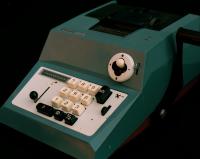 I found this Olivetti mechanical adding machine in a car boot sale
in Bristol.
I think it's another relic of the 1970s, because earlier models from
Olivetti (in the 1960s) would have been set up to add the old
pounds, shillings and pence.
This was the pre-decimalisation system of British money (before 1971)
where we had twenty shillings to a pound, and twelve pence to a shilling.
Farthings were also sometimes used, worth one quarter of a penny.
Although I do have two adding machines that work in "old money",
this Olivetti is decimal.
I found this Olivetti mechanical adding machine in a car boot sale
in Bristol.
I think it's another relic of the 1970s, because earlier models from
Olivetti (in the 1960s) would have been set up to add the old
pounds, shillings and pence.
This was the pre-decimalisation system of British money (before 1971)
where we had twenty shillings to a pound, and twelve pence to a shilling.
Farthings were also sometimes used, worth one quarter of a penny.
Although I do have two adding machines that work in "old money",
this Olivetti is decimal.
Singer-Friden 1117
A desktop calculator from the
nixie-tube generation.
Mains powered, but fitted with a carrying handle.
The Old Calculator Web Museum page on the Friden 1117
Vintage Calculators page on the Friden 1117
Photo of my calculator at Dorkbot Bristol
Photo of later version with 7-segment VFD
Texas Instruments TI-58C calculator
 The TI-58C was a later model in the Texas range, and included continuous
memory (hence the “C” in the name).
The ordinary TI-58 didn't have any long-term storage, but the more expensive
TI-59 had magnetic cards for storage.
All the TI machines in this range would accept little ROM cartridges in
the back, containing programs.
TI called this feature “Solid State Software”.
The calculator has a red LED display, a NiCad battery pack and a hard
plastic carrying case.
The TI-58C was a later model in the Texas range, and included continuous
memory (hence the “C” in the name).
The ordinary TI-58 didn't have any long-term storage, but the more expensive
TI-59 had magnetic cards for storage.
All the TI machines in this range would accept little ROM cartridges in
the back, containing programs.
TI called this feature “Solid State Software”.
The calculator has a red LED display, a NiCad battery pack and a hard
plastic carrying case.
Texas Instruments TI-59 calculator
 The TI-59 was top of the Texas range, with a magnetic card reader/writer
for non-volatile storage.
All the TI machines in this range would accept little ROM cartridges in
the back, containing programs.
TI called this feature “Solid State Software”.
The calculator has a red LED display, a NiCad battery pack and a hard
plastic carrying case.
The TI-59 was top of the Texas range, with a magnetic card reader/writer
for non-volatile storage.
All the TI machines in this range would accept little ROM cartridges in
the back, containing programs.
TI called this feature “Solid State Software”.
The calculator has a red LED display, a NiCad battery pack and a hard
plastic carrying case.
https://www.ti59.com/
Texas Instruments Programmer calculator
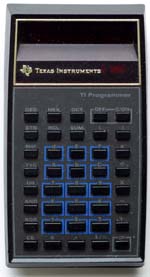 TI's special calculator for programmers, featuring hex, octal and
decimal modes.
It also has logical, bit-wise operations and, or, exor, ones complement
and shift.
The calculator has a red LED display and a NiCad battery pack.
TI's special calculator for programmers, featuring hex, octal and
decimal modes.
It also has logical, bit-wise operations and, or, exor, ones complement
and shift.
The calculator has a red LED display and a NiCad battery pack.
Texas Instruments TI-92 calculator
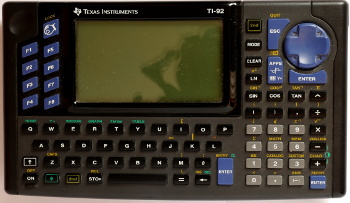 Introduced in 1995, the TI-92 has a 68000 processor.
It has a QWERTY keyboard and runs TI-BASIC.
The calculator has a liquid crystal display.
Introduced in 1995, the TI-92 has a 68000 processor.
It has a QWERTY keyboard and runs TI-BASIC.
The calculator has a liquid crystal display.
TI-92 series
Hewlett Packard HP16C calculator
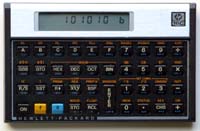 The calculator has an LCD display, and works in Reverse Polish.
It's one of the few HP Reverse Polish calculators that can work
in hexadecimal, octal and binary as well as in decimal (see the
HP32S for another).
The case of this calculator is obviously wider than it is tall,
but the display is still above the keyboard.
Note also the two “function shift” keys, labelled “f”
and “g” and colour-coded yellow and blue (the
HP32S has something similar).
Take a look at the Casio Personal Mini
for a really odd layout.
The calculator has an LCD display, and works in Reverse Polish.
It's one of the few HP Reverse Polish calculators that can work
in hexadecimal, octal and binary as well as in decimal (see the
HP32S for another).
The case of this calculator is obviously wider than it is tall,
but the display is still above the keyboard.
Note also the two “function shift” keys, labelled “f”
and “g” and colour-coded yellow and blue (the
HP32S has something similar).
Take a look at the Casio Personal Mini
for a really odd layout.
Hewlett Packard HP22 calculator
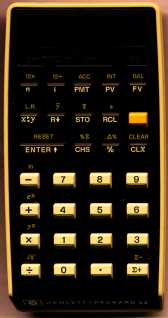 The calculator has an LED display, and works in Reverse Polish.
However, instead of the usual (for HP) scientific functions,
it has financial and accounting functions.
It runs on two AA sized NiCad batteries in a special HP pack.
I've successfully replaced the original NiCads with new ones
and restored the calculator to working order.
The calculator has an LED display, and works in Reverse Polish.
However, instead of the usual (for HP) scientific functions,
it has financial and accounting functions.
It runs on two AA sized NiCad batteries in a special HP pack.
I've successfully replaced the original NiCads with new ones
and restored the calculator to working order.
Hewlett Packard HP32S II calculator
 The calculator has an LCD display, and works in Reverse Polish.
Like the HP16C, it can display numbers in hex,
octal, binary or decimal notation.
Also like the HP16C,
it has two “function shift” keys, but on this machine
they are labelled with left and right arrows and colour-coded
orange and blue.
The calculator has an LCD display, and works in Reverse Polish.
Like the HP16C, it can display numbers in hex,
octal, binary or decimal notation.
Also like the HP16C,
it has two “function shift” keys, but on this machine
they are labelled with left and right arrows and colour-coded
orange and blue.
Hewlett Packard HP48G calculator
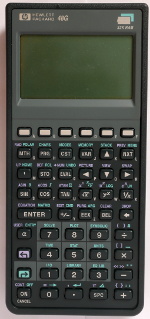 One of the later members of the
HP 48 series.
It has 32k of RAM.
Also like the HP16C,
it has two “function shift” keys,
but on this machine they are labelled with left and right arrows and
colour-coded purple and green.
One of the later members of the
HP 48 series.
It has 32k of RAM.
Also like the HP16C,
it has two “function shift” keys,
but on this machine they are labelled with left and right arrows and
colour-coded purple and green.
Casio Personal Mini calculator
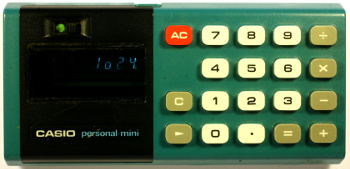 This calculator is unusual in that it has the display to the left
of the keyboard, instead of above it.
It makes the whole machine “landscape” styled, rather than
“portrait”, to use the printing terms.
Also, the display only shows six digits (instead of the usual eight)
and a shift key is used to view the upper six digits of a twelve-digit
result.
And as if that wasn't enough, the zeroes on the fluorescent display
are made up of just four segments of the seven-segment pattern.
This makes the zeroes half the height of all the other digits.
I must try to get this feature to show up on a scan or a photograph!
This calculator is unusual in that it has the display to the left
of the keyboard, instead of above it.
It makes the whole machine “landscape” styled, rather than
“portrait”, to use the printing terms.
Also, the display only shows six digits (instead of the usual eight)
and a shift key is used to view the upper six digits of a twelve-digit
result.
And as if that wasn't enough, the zeroes on the fluorescent display
are made up of just four segments of the seven-segment pattern.
This makes the zeroes half the height of all the other digits.
I must try to get this feature to show up on a scan or a photograph!
Casio Mini Memory calculator
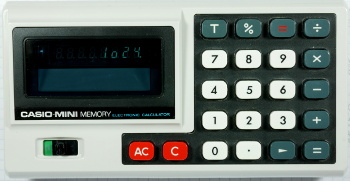 This calculator is an improved version of the one above.
It has the same horizontal or “landscape” styling,
and the same 6-digit display (although the VFD tube appears to have 8 digits)
with a shift arrow on the keyboard.
It has a few more buttons on the keyboard,
and a memory facility.
This calculator is an improved version of the one above.
It has the same horizontal or “landscape” styling,
and the same 6-digit display (although the VFD tube appears to have 8 digits)
with a shift arrow on the keyboard.
It has a few more buttons on the keyboard,
and a memory facility.
Photos of the interior
 My father used this
slide rule
for engineering calculations,
probably as early as 1938.
It's made of wood, with a cardboard sleeve with the name Faber Castell
on it.
The rule is 12 inches long, or about 300mm.
The longer a slide rule is, the more accuracy you can obtain.
My father used this
slide rule
for engineering calculations,
probably as early as 1938.
It's made of wood, with a cardboard sleeve with the name Faber Castell
on it.
The rule is 12 inches long, or about 300mm.
The longer a slide rule is, the more accuracy you can obtain.
 This is a slide rule made in the 1970s by the British Thornton company.
This type of slide rule was very commonly used in British schools
in the 1970s, right up until electronic calculators arrived.
It's another 12 inch (300mm) rule.
This is a slide rule made in the 1970s by the British Thornton company.
This type of slide rule was very commonly used in British schools
in the 1970s, right up until electronic calculators arrived.
It's another 12 inch (300mm) rule.
 I found this Olivetti mechanical adding machine in a car boot sale
in Bristol.
I think it's another relic of the 1970s, because earlier models from
Olivetti (in the 1960s) would have been set up to add the old
pounds, shillings and pence.
This was the pre-decimalisation system of British money (before 1971)
where we had twenty shillings to a pound, and twelve pence to a shilling.
Farthings were also sometimes used, worth one quarter of a penny.
Although I do have two adding machines that work in "old money",
this Olivetti is decimal.
I found this Olivetti mechanical adding machine in a car boot sale
in Bristol.
I think it's another relic of the 1970s, because earlier models from
Olivetti (in the 1960s) would have been set up to add the old
pounds, shillings and pence.
This was the pre-decimalisation system of British money (before 1971)
where we had twenty shillings to a pound, and twelve pence to a shilling.
Farthings were also sometimes used, worth one quarter of a penny.
Although I do have two adding machines that work in "old money",
this Olivetti is decimal.
 The TI-58C was a later model in the Texas range, and included continuous
memory (hence the “C” in the name).
The ordinary TI-58 didn't have any long-term storage, but the more expensive
TI-59 had magnetic cards for storage.
All the TI machines in this range would accept little ROM cartridges in
the back, containing programs.
TI called this feature “Solid State Software”.
The calculator has a red LED display, a NiCad battery pack and a hard
plastic carrying case.
The TI-58C was a later model in the Texas range, and included continuous
memory (hence the “C” in the name).
The ordinary TI-58 didn't have any long-term storage, but the more expensive
TI-59 had magnetic cards for storage.
All the TI machines in this range would accept little ROM cartridges in
the back, containing programs.
TI called this feature “Solid State Software”.
The calculator has a red LED display, a NiCad battery pack and a hard
plastic carrying case.
 The TI-59 was top of the Texas range, with a magnetic card reader/writer
for non-volatile storage.
All the TI machines in this range would accept little ROM cartridges in
the back, containing programs.
TI called this feature “Solid State Software”.
The calculator has a red LED display, a NiCad battery pack and a hard
plastic carrying case.
The TI-59 was top of the Texas range, with a magnetic card reader/writer
for non-volatile storage.
All the TI machines in this range would accept little ROM cartridges in
the back, containing programs.
TI called this feature “Solid State Software”.
The calculator has a red LED display, a NiCad battery pack and a hard
plastic carrying case.
 TI's special calculator for programmers, featuring hex, octal and
decimal modes.
It also has logical, bit-wise operations and, or, exor, ones complement
and shift.
The calculator has a red LED display and a NiCad battery pack.
TI's special calculator for programmers, featuring hex, octal and
decimal modes.
It also has logical, bit-wise operations and, or, exor, ones complement
and shift.
The calculator has a red LED display and a NiCad battery pack.
 Introduced in 1995, the TI-92 has a 68000 processor.
It has a QWERTY keyboard and runs TI-BASIC.
The calculator has a liquid crystal display.
Introduced in 1995, the TI-92 has a 68000 processor.
It has a QWERTY keyboard and runs TI-BASIC.
The calculator has a liquid crystal display.
 The calculator has an LCD display, and works in Reverse Polish.
It's one of the few HP Reverse Polish calculators that can work
in hexadecimal, octal and binary as well as in decimal (see the
The calculator has an LCD display, and works in Reverse Polish.
It's one of the few HP Reverse Polish calculators that can work
in hexadecimal, octal and binary as well as in decimal (see the
 The calculator has an LED display, and works in Reverse Polish.
However, instead of the usual (for HP) scientific functions,
it has financial and accounting functions.
It runs on two AA sized NiCad batteries in a special HP pack.
I've successfully replaced the original NiCads with new ones
and restored the calculator to working order.
The calculator has an LED display, and works in Reverse Polish.
However, instead of the usual (for HP) scientific functions,
it has financial and accounting functions.
It runs on two AA sized NiCad batteries in a special HP pack.
I've successfully replaced the original NiCads with new ones
and restored the calculator to working order.
 The calculator has an LCD display, and works in Reverse Polish.
Like the
The calculator has an LCD display, and works in Reverse Polish.
Like the  One of the later members of the
One of the later members of the
 This calculator is unusual in that it has the display to the left
of the keyboard, instead of above it.
It makes the whole machine “landscape” styled, rather than
“portrait”, to use the printing terms.
Also, the display only shows six digits (instead of the usual eight)
and a shift key is used to view the upper six digits of a twelve-digit
result.
And as if that wasn't enough, the zeroes on the fluorescent display
are made up of just four segments of the seven-segment pattern.
This makes the zeroes half the height of all the other digits.
I must try to get this feature to show up on a scan or a photograph!
This calculator is unusual in that it has the display to the left
of the keyboard, instead of above it.
It makes the whole machine “landscape” styled, rather than
“portrait”, to use the printing terms.
Also, the display only shows six digits (instead of the usual eight)
and a shift key is used to view the upper six digits of a twelve-digit
result.
And as if that wasn't enough, the zeroes on the fluorescent display
are made up of just four segments of the seven-segment pattern.
This makes the zeroes half the height of all the other digits.
I must try to get this feature to show up on a scan or a photograph!
 This calculator is an improved version of the one above.
It has the same horizontal or “landscape” styling,
and the same 6-digit display (although the VFD tube appears to have 8 digits)
with a shift arrow on the keyboard.
It has a few more buttons on the keyboard,
and a memory facility.
This calculator is an improved version of the one above.
It has the same horizontal or “landscape” styling,
and the same 6-digit display (although the VFD tube appears to have 8 digits)
with a shift arrow on the keyboard.
It has a few more buttons on the keyboard,
and a memory facility.